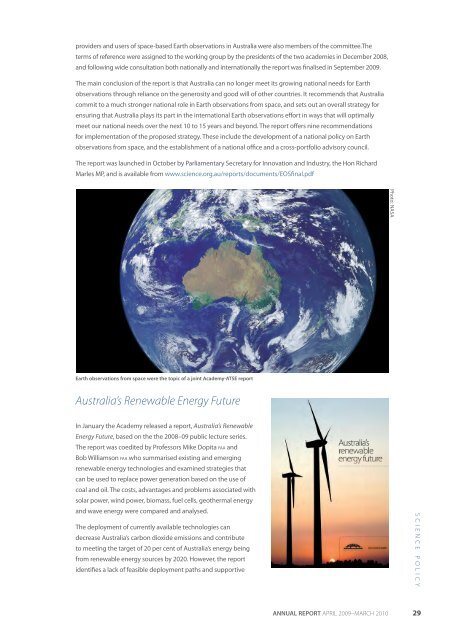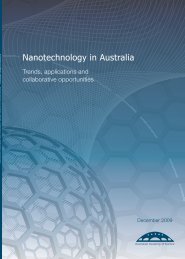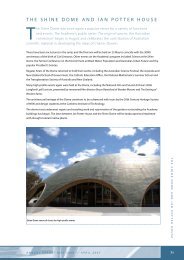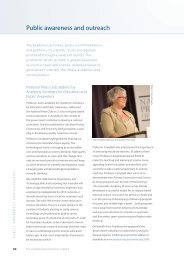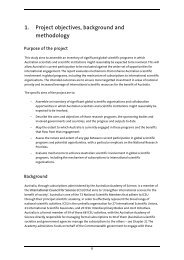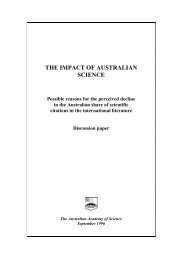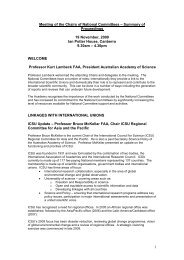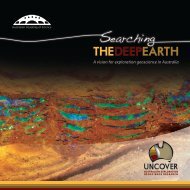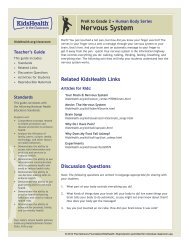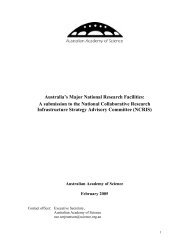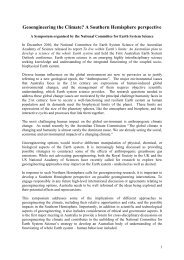ANNUAL REPORT - Australian Academy of Science
ANNUAL REPORT - Australian Academy of Science
ANNUAL REPORT - Australian Academy of Science
Create successful ePaper yourself
Turn your PDF publications into a flip-book with our unique Google optimized e-Paper software.
providers and users <strong>of</strong> space-based Earth observations in Australia were also members <strong>of</strong> the committee.The<br />
terms <strong>of</strong> reference were assigned to the working group by the presidents <strong>of</strong> the two academies in December 2008,<br />
and following wide consultation both nationally and internationally the report was finalised in September 2009.<br />
The main conclusion <strong>of</strong> the report is that Australia can no longer meet its growing national needs for Earth<br />
observations through reliance on the generosity and good will <strong>of</strong> other countries. It recommends that Australia<br />
commit to a much stronger national role in Earth observations from space, and sets out an overall strategy for<br />
ensuring that Australia plays its part in the international Earth observations effort in ways that will optimally<br />
meet our national needs over the next 10 to 15 years and beyond. The report <strong>of</strong>fers nine recommendations<br />
for implementation <strong>of</strong> the proposed strategy. These include the development <strong>of</strong> a national policy on Earth<br />
observations from space, and the establishment <strong>of</strong> a national <strong>of</strong>fice and a cross-portfolio advisory council.<br />
The report was launched in October by Parliamentary Secretary for Innovation and Industry, the Hon Richard<br />
Marles MP, and is available from www.science.org.au/reports/documents/EOSfinal.pdf<br />
Photo: NASA<br />
Earth observations from space were the topic <strong>of</strong> a joint <strong>Academy</strong>-ATSE report<br />
Australia’s Renewable Energy Future<br />
In January the <strong>Academy</strong> released a report, Australia’s Renewable<br />
Energy Future, based on the the 2008–09 public lecture series.<br />
The report was coedited by Pr<strong>of</strong>essors Mike Dopita FAA and<br />
Bob Williamson FAA who summarised existing and emerging<br />
renewable energy technologies and examined strategies that<br />
can be used to replace power generation based on the use <strong>of</strong><br />
coal and oil. The costs, advantages and problems associated with<br />
solar power, wind power, biomass, fuel cells, geothermal energy<br />
and wave energy were compared and analysed.<br />
The deployment <strong>of</strong> currently available technologies can<br />
decrease Australia’s carbon dioxide emissions and contribute<br />
to meeting the target <strong>of</strong> 20 per cent <strong>of</strong> Australia’s energy being<br />
from renewable energy sources by 2020. However, the report<br />
identifies a lack <strong>of</strong> feasible deployment paths and supportive<br />
SCIENCE POLICY<br />
<strong>ANNUAL</strong> <strong>REPORT</strong> APRIL 2009–MARCH 2010 29


